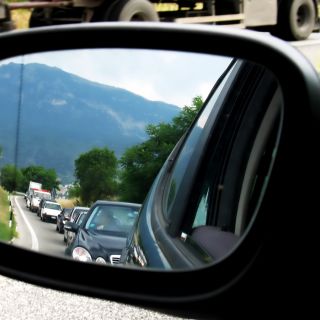Stress
How to Stress Less in a Traffic Jam
Stay calm and centered in the midst of bumper-to-bumper chaos.
Posted September 2, 2015

Traffic congestion is a frequent source of stress, anger and anxiety — and the problem, like your car in a traffic jam, isn’t going anywhere soon.
Consider these statistics in a recent report from the Texas A&M Transportation Institute: Rush-hour commuters in the United States lose an average of 42 hours per year to traffic delays caused by clogged highways. On the nation’s 10 most gridlocked roads, the number doubles to 84 hours. That’s three and a half days per year of sitting in traffic jams.
Spending hours stuck in traffic may take a toll on your health and happiness. Along with the potential for stress, it increases your exposure to traffic-related air pollution. And that, in turn, may raise the risk of having a heart attack or asthma flare-up.
Protect Your Health
The best solution is to steer clear of traffic congestion whenever possible. This can be a challenge if your commute to work or school passes through a high-traffic area. But keep an open mind about possible ways to reschedule or reroute your drive.
For example, let’s say you could avoid the worst rush-hour traffic by leaving home an hour earlier, but your work hours aren’t flexible. Maybe you could leave early anyway and spend that hour exercising and showering at a gym near your workplace.
Or let’s say taking the freeway is usually 15 minutes faster than surface streets. During peak hours, however, surface streets may actually be faster. Don’t automatically get on the freeway just because it’s a habit. In many areas of the United States, you can call 511 or use your maps app to get current traffic conditions and plan your route accordingly.
Reduce Your Stress
Once you’ve done what you can to avoid traffic jams, the next-best solution is to face them with greater equanimity. You can’t control the bottleneck around you, but you can manage your reaction to it. These evidence-based tips help you stay calmer and more centered in the midst of bumper-to-bumper chaos:
- Inhale, exhale, repeat. When you start gripping the steering wheel like a vise, take some deep breaths. This is not only a proven technique for eliciting relaxation. It's also simple enough to do behind the wheel.
- Redefine the situation. Rather than thinking of the traffic snarl as an obstacle to getting where you want to be, tell yourself it’s a welcome respite from work or a golden opportunity to listen to your favorite radio show.
- Curtail angry reactions. Don’t expect to eliminate every negative feeling. If you feel a flash of annoyance when a driver cuts you off, that’s okay. Notice and accept what you’re feeling in the present moment — and then move on to the next moment. This helps stop yourself from fuming over the other driver’s behavior, so a split-second of irritation doesn’t turn into full-blown road rage.
- Quell anxious thoughts. Likewise, if you feel a twinge of worry over being late, approach it with the same mindful attitude. Notice and accept the feeling nonjudgmentally, and then let it go. Turn your awareness to what's happening in the present moment: the sight of vehicles moving (or not) around you, the sound of sirens in the distance, the feel of your foot on the pedals.
- Put on a happy face. When you’re doing 10 miles per hour in the fast lane, smile. If you’re able to see the humor in the situation, that’s a great stress reliever. But even if you’re faking the smile, research suggests that going through the motions of smiling may reduce the intensity of your body’s stress response.
Turn On Some Tunes
One study that looked at rush-hour stress directly was led by Stephen Fairclough, Ph.D., a professor of psychophysiology at Liverpool John Moores University in England. In his clever study, volunteers “drove” a set route using a driving simulator. They were told that they had to complete the route within eight minutes to receive a £10 payment. They would be fined £2 each time they broke the speed limit.
What volunteers didn’t know was that the game was rigged: Halfway into the journey, they encountered a traffic jam, which kept them from finishing on time. (Once volunteers completed the study, the ruse was revealed, and they were paid in full.)
The goal was to see how different types of music would affect the volunteers’ reaction to the simulated traffic jam. In particular, researchers were interested in how music would influence cardiovascular reactivity. “When we are stuck in traffic and anxious about not making it to our destination in time, we don’t just feel stressed or angry,” Fairclough told me. “There are a number of changes that take place in the body, such as increased heart rate and blood pressure.”
His study results show that music really does have charms to soothe the savage driver. “We found that blood pressure increased during the traffic jam, especially when people listened to aggressive music or no music at all,” Fairclough said. “The exception was participants who listened to music that was characterized as low activation, which was either soothing or sad.”
The upshot: Tune in to an easy listening, smooth jazz or soft rock radio station, depending on what you like. Or create a “soothing songs” playlist for your portable music device. Then hit play before you brave rush-hour madness.
Linda Wasmer Andrews writes about health, psychology and the intersection of the two. Connect with her on Twitter and Facebook. Read more from her blog:
Relaxing Music: Q&A with Conductor Keith Lockhart
Sniffling and Driving: A Dangerous Mix
The Art of Waiting in Line


